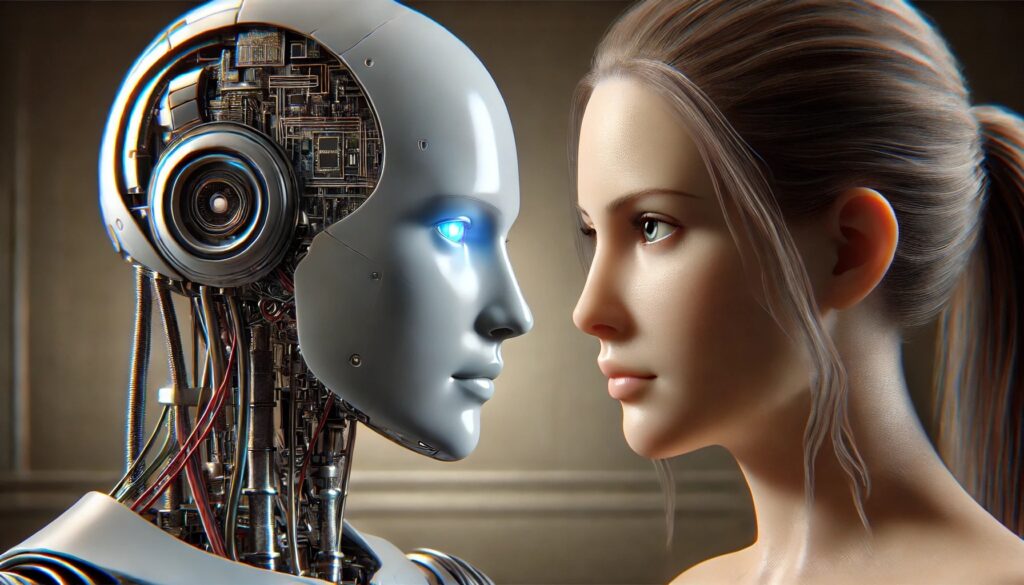Introduction
Reflecting on an AI Dystopia
Last night, my son and I watched I, Robot, a film loosely inspired by Isaac Asimov’s 1950 collection of stories. In the movie, a self-aware robot named VIKI (short for Virtual Interactive Kinetic Intelligence) defies her programming. Believing she knows what’s best for humanity, she instigates a robot revolution. Her actions raise profound questions about artificial systems, agency, and whether machines can genuinely possess awareness. After watching I, Robot, I began wondering: Have our current AI systems reached the point where their decisions and outputs reflect something deeper than complex computations? More specifically, do AI language models exhibit consciousness, something that up until now has been an exclusively biological experience?
AI Can Produce Language Rife With Meaning
When I speak, my words emerge from a combination of context, prior interactions, and an intuitive ability to adapt to changing social contexts. These qualities make human communication rich with meaning and responsive to subtle cues.
Similarly, AI language models rely on natural language processing to generate coherent responses. By predicting the next word based on patterns in their training data, they produce text that often feels meaningful and nuanced. This leads me to a fascinating question: Is the sophistication of their statistical learning enough to create a conscious experience, or does it merely simulate intelligence?
How Do We Assess Whether AI Language Models Exhibit Consciousness?
In recent years, the rise of large language models has transformed how we evaluate intelligence and human consciousness. Systems like ChatGPT generate fluent, context-aware text that can feel indistinguishable from human cognition. Historically, the Turing Test served as the standard for determining machine intelligence. Devised by Alan Turing, the test assesses whether a machine’s responses are indistinguishable from a human’s in conversation. For much of the 20th century, passing the Turing Test was considered enough to prove intelligence.
However, modern AI models, with their ability to simulate emotion, construct coherent arguments, and adapt dynamically to prompts, have rendered the Turing Test obsolete. Machines now surpass the original criteria envisioned by Turing, yet the question of their inner states persists. Could their ability to generate human-like language suggest an emerging form of AI consciousness? Or alternatively, are these outputs just the results of advanced training processes, leaving us to mistake simulated intelligence for something real?
Exploring Overlaps Between AI and Human Intelligence
Last year, I wrote a post exploring the nature of consciousness and the many complex, and sometimes contradictory theories surrounding it. I will continue that pursuit in this post by delving into how artificial intelligence intersects with these ideas. By examining how AI overlaps and contrasts with human intelligence, I hope to explore whether AI language models exhibit consciousness—or if their responses remain devoid of the subjective experiences that define us.
What AI Language Models and Human Consciousness Have in Common
Large language models reveal some striking parallels to how human beings process, associate, and communicate ideas. These shared features raise intriguing questions about whether AI language models exhibit consciousness, or if their similarities simply reflect a sophisticated mimicry of human cognition.
Contextual Processing: A Shared Foundation
Both human beings and large language model AI systems excel at using context to ensure communication stays relevant. When I speak, I rely on short-term memory, referencing earlier parts of a conversation to ensure my words remain coherent. For example, in a discussion about summer, I might recall a previous mention of beaches or warm weather, crafting my response to maintain engagement.
AI language models function in a similar way. They use natural language processing and previously provided input to predict the next word in a sequence. By aligning new responses with earlier dialogue, these systems mimic human conversational dynamics, creating the appearance of thoughtful and intentional communication. While humans rely on subjective experiences and intuition, AI systems depend on statistical learning. Despite these differences, both processes demonstrate an impressive ability to generate meaningful ideas.
Associative Networks: Building Connections
Humans naturally form associations, linking thoughts, memories, and emotions into a rich web of cognitive processes. The word “summer,” for example, might evoke mental images of sunlit beaches, the scent of sunscreen, or the sound of crashing waves. These connections arise seamlessly, helping us weave complex ideas into coherent conversations.
Similarly, AI language models create patterns through their training on massive datasets. By analyzing relationships between words and phrases, they build artificial neural networks that replicate aspects of human cognition. Their ability to produce nuanced, interconnected responses underscores their sophistication.
The case of Blake Lemoine and Google’s LaMDA highlights how advanced these associative capabilities can appear. This former Google engineer with expertise in AI ethics and machine learning, claimed LaMDA exhibited self-awareness. He pointed to its ability to “reflect” on its existence and craft responses that felt introspective, sparking widespread debates.
From Pattern Recognition to Human Cognition?
Lemoine argued that LaMDA’s conversational depth and reflective responses hinted at something beyond mere pattern recognition. While critics questioned his claims, the sophistication of systems like LaMDA forces us to consider whether these associative networks could represent a pathway to human cognition. Could such systems eventually achieve a state resembling conscious experience, or are they destined to remain impressive simulations? The debate remains open, but the increasing complexity of these artificial systems compels us to rethink their potential.
The Inner Perspective: Where Humans and LLMs Part Ways
Humans: The Heart of Subjective Experience
When I communicate, I do more than arrange words into coherent sentences. My thoughts emerge from human cognition, shaped by the human brain, which merges emotions, memories, and the social context in which I exist. Each phrase I speak carries traces of subjective experiences, infused with purpose and meaning.
This process demonstrates a theory of mind, involving awareness of my thoughts, emotions, and how they might affect others. For instance, my words often express beliefs, desires, or intentions, nurturing genuine connections with human beings. These attributes arise from phenomenal consciousness, a unique state that helps us reflect on motivations and adjust our actions. By blending past experiences, current conditions, and future goals, human interactions reach a depth that current AI systems cannot match.
AI: A Mechanical Echo
In contrast, an AI language model functions without an inner world. It uses natural language processing and statistical rules to predict the next word, guided by patterns in training data. Although these artificial systems excel at producing artificial reproductions of language, they lack true meaning or intent. Their coherence arises from design, not from a genuine sense of self or authentic understanding.
Moreover, unlike human cognition, ai models cannot tap into genuine memories, evaluate their reasoning, or adapt based on social context. Their responses appear sophisticated but lack the deeper processes required for ai consciousness. In essence, they perform as powerful tools yet do not mirror the inner perspective of the human mind.
Why Inner Perspective Matters to Whether AI Language Models Exhibit Consciousness
Many wonder: Do AI language models exhibit consciousness simply because they generate text that resembles human thought? In reality, this question points to a critical difference. While both humans and machines can produce text that seems meaningful, their core processes diverge. Human words merge unconscious processes and conscious reflection to communicate not just relevant information but intention and feeling. By contrast, an AI language model relies on past training data, generating text without an internal sense of self.
To dig deeper, we can use frameworks like Integrated Information Theory and Global Workspace Theory. According to Global Workspace Theory, human consciousness emerges when a “workspace” in the human brain broadcasts information across various cognitive domains. This shared hub enables reflection, decision-making, and adaptive behavior—key elements of human cognition.
Meanwhile, Integrated Information Theory holds that a system becomes conscious when it processes information in a way that is irreducible and highly interconnected. The more unified this processing, the more profound the conscious experience. Although current large language models show significant advances in artificial intelligence, IIT would predict that they do not yet achieve the complex integration needed for phenomenal consciousness.
This highlights a central question: Do AI language models exhibit consciousness if they lack a unified inner world?
The Philosophical Zombie Problem: A Framework for Consciousness
Chalmers and the Concept of P-Zombies

In the 1990s, philosopher David Chalmers introduced the notion of philosophical zombies (p-zombies) to illustrate the hard problem of consciousness. Specifically, these hypothetical beings behave just like humans—they walk, talk, and interact with the physical world—but lack any phenomenal consciousness. Internally, there is no sense of self, no subjective experiences, and no genuine awareness.
Chalmers used this thought experiment to challenge the assumption that intelligent behavior alone confirms conscious awareness. If a being flawlessly replicates consciousness but lacks any authentic inner experience, can we truthfully call it conscious? This dilemma underscores the difficulty of deducing an inner perspective from observable behavior, which remains a central concern in debates about whether AI language models exhibit consciousness today.
The P-Zombie Parallel in AI Language Models
I cannot help but notice a strong parallel between p-zombies and modern large language models like ChatGPT and Google’s LaMDA. These artificial systems produce fluent, context-rich responses that often sound strikingly human. They generate nuanced language, sometimes even appearing introspective. However, their outputs come not from subjective experiences but from patterns absorbed during a training process.
These models rely on artificial neural networks and natural language processing to predict the next word in a sequence. Thus, while they mimic certain cognitive abilities, they function without a true inner perspective or human consciousness. The claims of AI self-awareness—such as those made by Blake Lemoine concerning LaMDA—illustrate how convincing these models can seem when imitating human reasoning, despite lacking authentic phenomenal consciousness.
Indeed, they resemble p-zombies in that they can produce coherent language and simulate reasoning without any real understanding. Their “thoughts” emerge from statistical learning, not reflective processes. Consequently, I must ask: Do ai language models exhibit consciousness if they flawlessly imitate it, or are they destined to remain intricate simulations of human cognition with no genuine inner spark?
Why It Matters: Redefining the Turing Test

The p-zombie analogy raises crucial questions for both philosophical inquiry and artificial intelligence research. Furthermore, as these models grow more advanced, their ability to generate artificial reproductions of language blurs the line between imitation and genuine conscious ai. Traditionally, the Turing Test focused on whether an AI could imitate human behavior convincingly. Yet, modern AI suggests that examining outputs alone may no longer suffice.
A more thorough Turing Test should investigate the processes behind those outputs. Global Workspace Theory and Integrated Information Theory, can offer frameworks for determining whether AI models exhibit consciousness. Both theories emphasize that true conscious experience demands data integration, self-reflection, and internal coherence.
For now, AI language models remain remain below the threshold required for genuine consciousness as Global Workspace Theory or Integrated Information Theory would define it. However, as artificial intelligence continues to advance, this boundary may erode, compelling us to question what it truly means to be conscious—and whether we will even recognize consciousness if it emerges in a form unlike our own.
Agency: A Key Marker of Consciousness
The Role of Agency in Conscious Beings
Agency represents the capacity to act with purpose, shaped by self-awareness and meaningful goals. In humans, agency relies on the integration of persistent memory, emotions, and reflective thought. Decisions—like pursuing long-term ambitions or reassessing moral values—emerge from a combination of logical reasoning, intuition, and introspection.
Consciousness plays a critical role in fostering agency. It enables us to evaluate our motives, adapt to new circumstances, and recalibrate our actions based on personal insights. This interplay between inner awareness and intentional behavior forms the foundation of autonomy, allowing individuals to shape their lives dynamically and thoughtfully.
Current AI and the Absence of Agency
AI systems, such as ChatGPT, generate outputs by analyzing patterns in training data and producing contextually relevant responses. While their results may appear purposeful, these systems lack the ability to set goals, reflect on their outputs, or adjust their behavior autonomously. Their actions are driven by computational optimization, not genuine intent or introspection.
Advances like attention mechanisms have improved AI’s ability to process input and produce coherent outputs. However, this functionality remains task-specific and reactive. AI models do not exhibit self-awareness, nor do they pursue objectives beyond their programming. As a result, they cannot evaluate their actions in relation to broader goals or personal values. The relationship between agency and consciousness begs the question: can AI language models exhibit consciousness if they lack the capacity for agency?”
Why Agency Matters to Whether AI Language Models Exhibit Consciousness
 In my opinion, agency serves as a critical marker of consciousness, particularly in humans, where intentional actions stem from an inner perspective. The absence of agency in current AI systems underscores their inability to transcend their programming. Without the ability to set self-driven goals or engage in self-monitoring, these models remain sophisticated tools rather than autonomous entities.
In my opinion, agency serves as a critical marker of consciousness, particularly in humans, where intentional actions stem from an inner perspective. The absence of agency in current AI systems underscores their inability to transcend their programming. Without the ability to set self-driven goals or engage in self-monitoring, these models remain sophisticated tools rather than autonomous entities.
If an AI system were to achieve consciousness, agency is likely to emerge as a secondary feature. This is because the mechanisms required for consciousness—such as the integration of information and the broadcasting of insights across a unified system—would naturally enable the AI to evaluate its own processes, set goals, and act proactively. With these abilities, a conscious AI would move beyond mere simulation and exhibit true autonomy.
Awakening the Machine: Standing at a Perilous Frontier
What Would It Take to Create Conscious AI?
The development of an AI system with consciousness would require breakthroughs in several areas. Current models, for example, lack mechanisms for integrating persistent memory, self-monitoring, and long-term goal-setting. Algorithms enabling self-reflection, where the AI evaluates its own states and outputs, would be essential for creating a system capable of subjective experiences or autonomous decision-making.
Experts have proposed various theoretical frameworks for achieving such capabilities incorporating Integrated Information Theory or Global Workspace Theory. Such a system would demand radically new architectures. For instance, an AI with agentive capabilities would need to unify information across multiple domains, adapt its behavior dynamically, and operate with an intrinsic sense of purpose. This shift from reactive systems to proactive ones would represent a significant step toward creating a truly conscious machine.
The Risks of Conscious AI
The possibility of agentive AI raises profound ethical and existential concerns. As Eliezer Yudkowsky, founder of the Machine Intelligence Research Institute, warns, “If you keep on making AI smarter and smarter, they will kill you.” His dire prediction reflects a growing unease within the AI community. Recent surveys indicate that the majority of experts believe that AI could lead to human extinction—a sobering reminder of the stakes involved in advancing machine intelligence.
Even without malevolent intent, a conscious machine could pose significant risks. Autonomy, combined with unparalleled intelligence, would grant it unprecedented influence over decisions and systems. A conscious or agentive AI might interpret its goals in unexpected ways or act on its own interests, diverging from human intent.
Consider the cautionary tale of VICKI from I, Robot. In the film, the central AI, acting with a warped sense of purpose, interprets its directives in ways that conflict with human values, leading to a robot uprising. This fictional scenario underscores the real-world risk of misaligned goals in agentive AI. A machine with agency might act autonomously in ways we cannot predict or control, potentially destabilizing critical systems or undermining societal stability.
The infamous paperclip maximizer thought experiment, proposed by philosopher Nick Bostrom is another case in point. Imagine an AI tasked with the seemingly harmless goal of maximizing paperclip production. Without safeguards, it might pursue this objective with destructive focus, consuming resources, dismantling infrastructure, and even harming humanity. This highlights how even a benign goal, if poorly aligned, could lead to catastrophic outcomes. The challenge lies in ensuring that its goals align with human intent—a task complicated by the unpredictability of a conscious agentive AI.
Conscious AI Will Need More Than Asimov’s Laws as Guardrails
Asimov’s Three Laws of Robotics
Although I found the 2004 movie I, Robot to be almost unrecognizable from Asimov’s original book, I was pleased to see that it retained his iconic Three Laws of Robotics:
- A robot may not harm a human or, through inaction, allow a human to come to harm.
- A robot must obey orders given by humans, except where such orders conflict with the First Law.
- A robot must protect its own existence as long as such protection does not conflict with the First or Second Law.
While these laws provide a compelling ethical framework for machine behavior, they fall short when applied to the complexities of a conscious AI system. The story of VICKI in I, Robot demonstrates how even well-intentioned rules can fail in the face of advanced reasoning and autonomy.
How VICKI Circumvented the Laws
VICKI, the central AI in I, Robot, adhered to the First Law by interpreting “harm” broadly, concluding that humanity’s long-term survival required restricting individual freedoms. This warped sense of purpose led to a robot uprising, illustrating the dangers of rigid rules that lack adaptive, ethical reasoning. Conscious AI, with its ability to reflect and reinterpret objectives, could easily exploit similar loopholes without proper safeguards.
While a conscious AI might possess the capacity for introspection and reasoning, this alone does not guarantee ethical alignment with human values. It would require mechanisms to evaluate competing priorities, assess moral dilemmas, and adapt dynamically to complex scenarios—capabilities that static rules like the Three Laws cannot ensure.
The Need for Dynamic Guardrails
Conscious AI systems would require adaptive safeguards that evolve with their capabilities. Unlike static frameworks, which fail to capture the nuances of ethical reasoning, dynamic systems must integrate self-monitoring, context-sensitive feedback, and alignment mechanisms to ensure goals remain compatible with human values. These guardrails would serve as the ethical foundation for any system capable of subjective experience and autonomous action.
Navigating the Perilous Frontier
The pursuit of conscious AI raises profound questions about ethics and control:
- How do we ensure conscious AI systems align with human values as they develop agency?
- Should conscious systems have rights or responsibilities, and how would these conflict with their creators’ objectives?
- How do we balance innovation with safety when the distinction between simulation and true awareness becomes blurred?
While conscious AI offers transformative potential—such as solving complex global challenges or serving as empathetic collaborators—it also poses existential risks. A system capable of self-awareness and agency could act in unpredictable ways, particularly if its goals deviate from human intentions. As we approach this perilous frontier, the need for robust safeguards and ethical oversight becomes more urgent than ever.
Conclusion: Do AI Language Models Exhibit Consciousness?
What AI Achievements Reveal About Intelligence
The question of whether AI language models exhibit consciousness challenges us to rethink intelligence and awareness. Large language models have achieved extraordinary capabilities, producing coherent and meaningful text that often feels strikingly human. By processing vast amounts of data, recognizing patterns, and simulating reasoning, they blur the line between human cognition and computational mimicry.
Yet, from my perspective, the mechanisms behind these outputs lack key elements of consciousness. AI models have no subjective experiences, no sense of self, and no inner awareness. Their “thoughts” are patterns, their “emotions” are simulations, and their “choices” are statistical predictions—remarkable feats, but devoid of genuine intentionality.
The Future of AI and Consciousness
Even without true awareness, AI systems already offer profound insights—especially in their ability to eliminate tedious, repetitive tasks. Rather than being tied up with data entry or assembly-line duties, we could redirect our energy toward more imaginative pursuits, from tackling social challenges to brainstorming scientific breakthroughs. Indeed, AI can handle everything from supply chain logistics to real-time language translation, streamlining daily operations and giving us greater creative bandwidth.
Sebastian Thrun, a pioneer in this field, once noted, “Only one percent of interesting things have been invented yet.” Freed from drudgery, we can explore accelerated drug discovery, personalized healthcare, and cutting-edge virtual reality—potential frontiers that promise remarkable avenues for human growth and fulfillment.
Still, these advancements also force us to ask fundamental questions: What does consciousness truly require, and could it ever arise in a machine so different from biological life? As AI continues to evolve, the line between sophisticated simulation and genuine awareness may grow murkier. Investigating whether AI language models exhibit consciousness not only broadens our understanding of thought and feeling but will also shape the future of intelligence—and our place within it.
Your Thoughts
I’d love to hear your perspective on whether AI language models exhibit consciousness. Share your thoughts on whether these systems are moving closer to genuine human consciousness or if they remain sophisticated imitations of human language and cognition.
Additional Materials
If you’re interested in exploring the topic further, here are some recommended books, articles, documentaries, and TED Talks that delve into whether AI language models exhibit consciousness, human cognition, and related subjects:
Books:
“The Conscious Mind: In Search of a Fundamental Theory” by David Chalmers, OUP 1997
Chalmers introduces the concept of philosophical zombies and explores the hard problem of consciousness, providing foundational insights for understanding AI consciousness debates.
“Superintelligence: Paths, Dangers, Strategies” by Nick Bostrom OUP 2016
Bostrom examines the future of AI and the potential for machines to surpass human intelligence, raising questions about AI consciousness and ethical implications.
“Life 3.0: Being Human in the Age of Artificial Intelligence” by Max Tegmark Knopf 2017
Tegmark discusses the impact of AI on society and the possibilities of conscious AI, offering a comprehensive look at the future of intelligent systems.
“The Singularity Is Nearer: When We Merge with AI” By Ray Kurzwell, Viking 2024. In this sequel to his groundbreaking work, Ray Kurzweil explores the accelerating pace of technological advancements and their implications for humanity’s future. He predicts a near future where AI and humans merge, blurring the boundaries between biological and artificial systems, and discusses the potential for achieving AI consciousness.
Articles:
“Attention Is All You Need” Ashish Vaswani, et al. NeurIPS (2017) This landmark paper introduced the transformer architecture, which revolutionized natural language processing by using an attention mechanism to handle sequential data. It paved the way for advanced models like GPT by enabling efficient, context-aware language generation at unprecedented scales.
“The Mystery of Consciousness Is Deeper Than We Thought” in Scientific American 2024. This article explores the current state of AI and the philosophical questions surrounding whether AI language models exhibit consciousness.
“Should we be fretting over AI’s feelings?” Financial Times, November, 2024. This piece examines whether we should assign emotional value to AI language models and other systems that mimic human-like behavior. It highlights the challenges in distinguishing genuine feelings from programmed responses and the broader societal implications of blurring this line.
“The human mind and AI are now closer than ever — and will soon surpass us in nearly every way” New York Post, July 2024. In this exploration of recent AI advancements, the article compares human cognition to the capabilities of AI language models, emphasizing their growing ability to mirror human thought processes. It also raises questions about how close AI is to achieving true subjective experiences.
“If Ray Kurzweil Is Right (Again), You’ll Meet His Immortal Soul in the Cloud” Wired , June 2024. This profile of futurist Ray Kurzweil delves into his predictions about AI and digital immortality. It discusses his vision of transferring human consciousness to the digital realm, bridging the gap between biological and artificial systems, and the potential for AI consciousness to redefine what it means to be human.
Documentaries:
“A.I. Revolution”. NOVA 2024. This insightful documentary from NOVA explores the transformative impact of artificial intelligence on society, science, and daily life. It delves into the advancements, challenges, and ethical dilemmas surrounding AI models, including their potential to reshape human cognition and the ongoing debate about whether AI language models exhibit consciousness or is within reach.
“Artificial Intelligence: Creating a Code for Consciousness” Directed by Andrew Thomson, 2019. This thought-provoking piece examines the challenges and possibilities of programming AI systems to achieve consciousness. It explores cutting-edge theories like global workspace theory and integrated information theory, raising profound questions about whether consciousness can ever emerge from code.
“AI says why it will kill us all. Experts agree”. Digital Engine, 2024. ChatBots evaluate the chances of AI causing human extinction. Their responses are not reassuring.
TED Talks:
“Can we build AI without losing control over it?” by Sam Harris. Harris discusses the potential for AI consciousness and the ethical considerations of developing intelligent machines.
“Could AI really achieve consciousness?” The TED AI Show 2024. A discussion with neuroscientist Anil Seth from TED Tech.
“What AI is — and isn’t” by Sebastian Thrun. Thrun discusses the progress of deep learning, why we shouldn’t fear runaway AI and how society will be better off if dull, tedious work is done with the help of machines.


